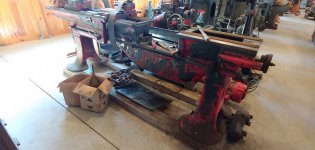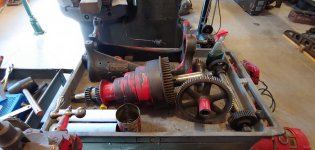Rule_So_Hard
Plastic
- Joined
- Apr 10, 2015
I have a 1870s putnam. 6.5' long overall. When.i purchased it it came with a load of parts and fortunately in the load of parts came all the threading gears.
Unfortunately I could never quite figure out how to make the threading mechanism work. After looking and all the pictures I could find I couldn't quite envision it but recently my buddy bought a putnam similar to mine and we were able to get out eyes in it and realized the parts we needed came with the lathe and I've been looking at them all along.
Two problems we've run into...
#1 they hacked together the carriage drive by make some hacked up form of a pulley driven off the idler instead of the spindle. I now see there is supposed to be a flat pulley on the spindle to drive the carriage. I need to figure out the size of this pulley so Ican get my carriage drive correct.
#2 they for some reason made a idler spacer with a steel bushing instead of brass and then pulley on the idler is slightly over sized. Not a huge deal because I have to make a bushing or buy a bushing anyways.
Unfortunately I could never quite figure out how to make the threading mechanism work. After looking and all the pictures I could find I couldn't quite envision it but recently my buddy bought a putnam similar to mine and we were able to get out eyes in it and realized the parts we needed came with the lathe and I've been looking at them all along.
Two problems we've run into...
#1 they hacked together the carriage drive by make some hacked up form of a pulley driven off the idler instead of the spindle. I now see there is supposed to be a flat pulley on the spindle to drive the carriage. I need to figure out the size of this pulley so Ican get my carriage drive correct.
#2 they for some reason made a idler spacer with a steel bushing instead of brass and then pulley on the idler is slightly over sized. Not a huge deal because I have to make a bushing or buy a bushing anyways.







